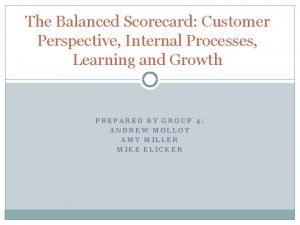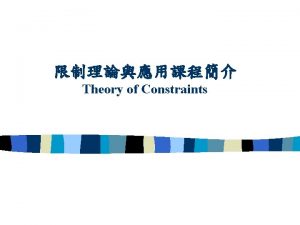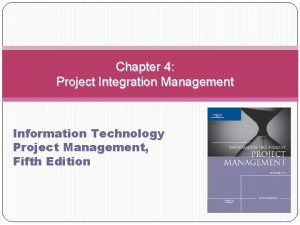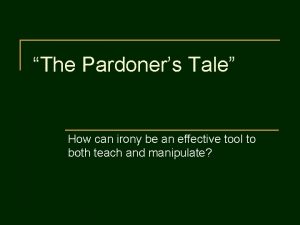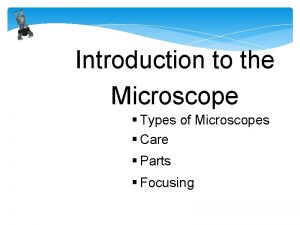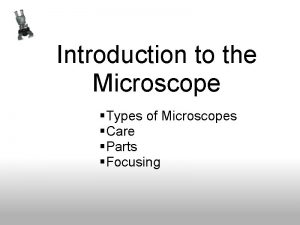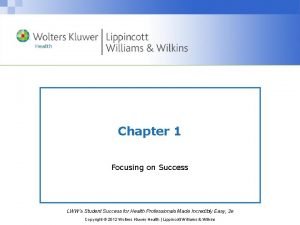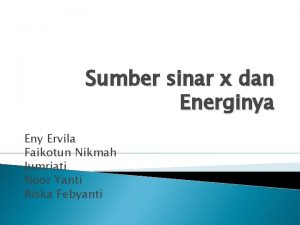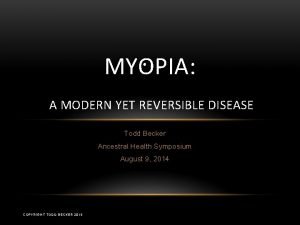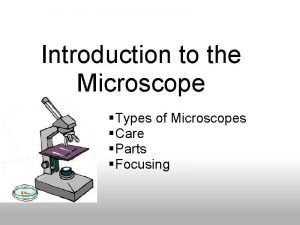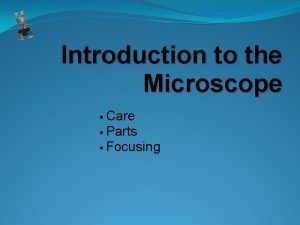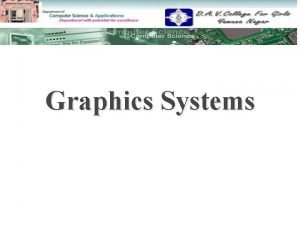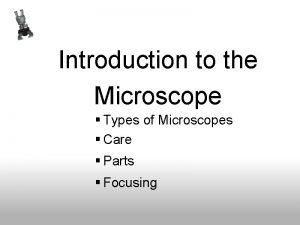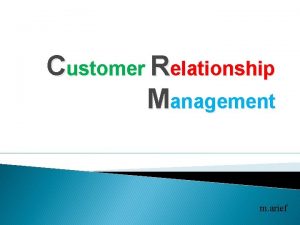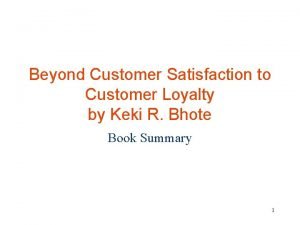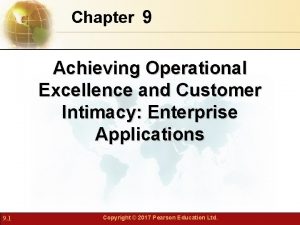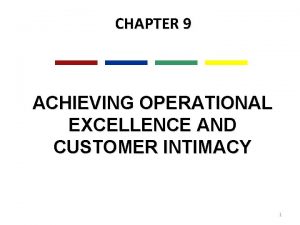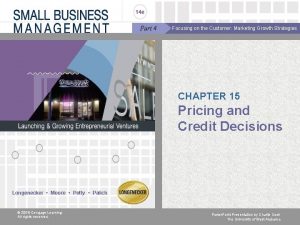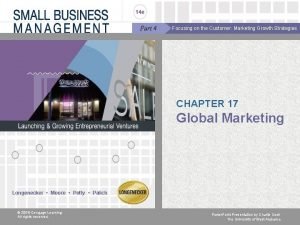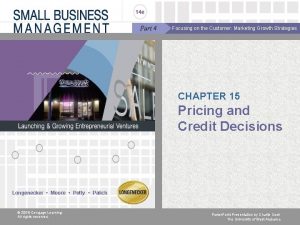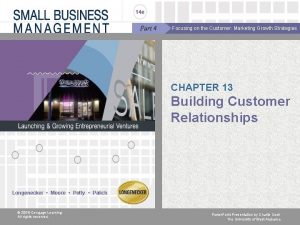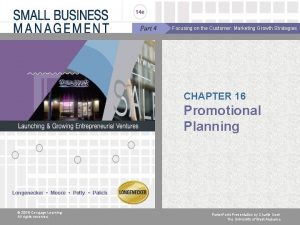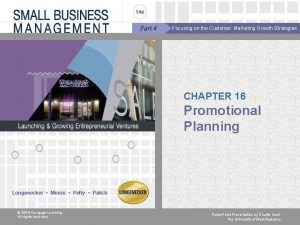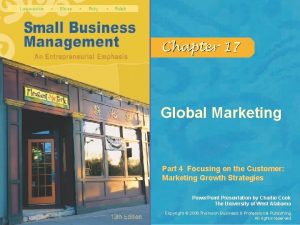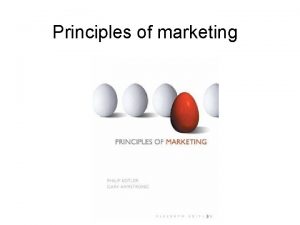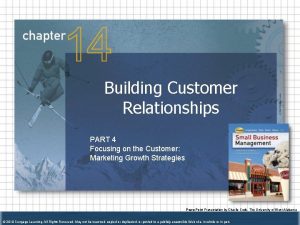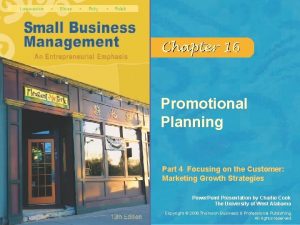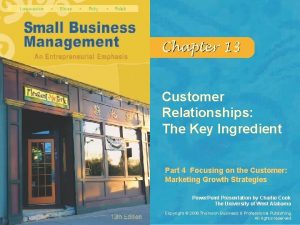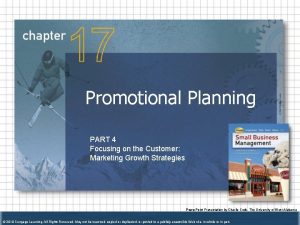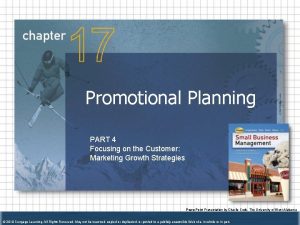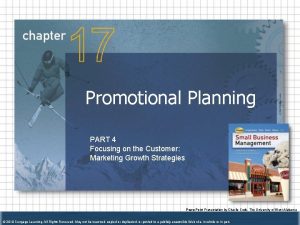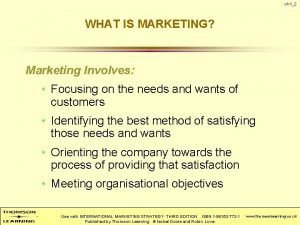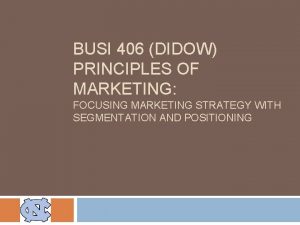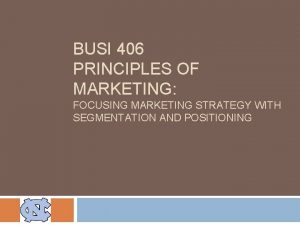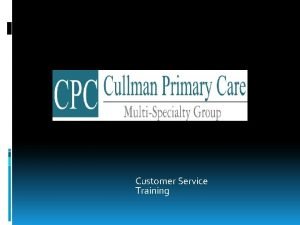Part 4 Focusing on the Customer Marketing Growth









































- Slides: 41

Part 4 Focusing on the Customer: Marketing Growth Strategies CHAPTER 14 Product and Supply Chain Management Longenecker • Moore • Petty • Palich © 2008 Cengage Learning. All rights reserved. Power. Point Presentation by Charlie Cook The University of West Alabama

Looking AHEAD After you have read this chapter, you should be able to: 1. Explain the challenges associated with growth in a small firm. 2. Explain the role of innovation in a firm’s growth. 3. Identify stages in the product life cycle and the new product development process. 4. Describe the building of a firm’s total product. 5. Explain product strategy and the alternatives available to small businesses. 6. Describe the legal environment affecting product decisions. 7. Explain the importance of supply chain management. 8. Specify the major considerations in structuring a distribution channel. © 2008 Cengage Learning. All rights reserved. 2

To Grow or Not to Grow • Growth sufficient to maintain the status quo is a goal of some entrepreneurs. • Growing a business too quickly can be stressful for the small firm. • A “growth trap” may occur when a firm’s growth soaks up cash faster than it can be generated. • Growth also puts pressure on a small firm’s personnel. © 2008 Cengage Learning. All rights reserved. 3

Innovation: A Path to Growth • Competitive Advantage and Innovation Ø Innovation and entrepreneurship often go hand-in- hand. Ø Coming up with and perfecting new products or services is often not easy. Ø The risk of failure increases when innovation is the goal. Ø Innovation is a means by which a firm can sustain its competitive advantage. © 2008 Cengage Learning. All rights reserved. 4

Reducing the Risk of Failure While Innovating • Base innovative efforts on your experience. • Focus on products or services that have been largely overlooked. • Be sure there is a market for the product or service you are hoping to create. • Pursue innovation that customers will perceive as adding value to their lives. • Focus on new ideas that will lead to more than one product or service. • Raise sufficient capital to launch the new product or service. © 2008 Cengage Learning. All rights reserved. 5

Sustainability and Innovation • Sustainable Competitive Advantage (SCA) Ø A value-creating position likely to endure over time v Is difficult to imitate v Creates high barriers to market entry v Can be patented or copyrighted v Is renewable at higher performance capabilities • Stages in the Competitive Advantage Life Cycle Ø Develop: invest resources Ø Deploy: boost performance Ø Decline: competitors overcome advantage © 2008 Cengage Learning. All rights reserved. 6

14 -1 The Competitive Advantage Life Cycle © 2008 Cengage Learning. All rights reserved. 7

14 -2 Sustaining Competitive Advantage © 2008 Cengage Learning. All rights reserved. 8

The Product Life Cycle and New Product Development • Product Life Cycle Ø A detailed picture of what happens to a specific product’s sales and profits over time v Promotion, pricing, and distribution policies must be adjusted to the product’s position on the curve. v It is important to rejuvenate product lines before they die. v The life cycle of a product follows the classic sigmoid curve—innovation is necessary for a firm’s survival. © 2008 Cengage Learning. All rights reserved. 9

14 -3 The Product Life Cycle © 2008 Cengage Learning. All rights reserved. 10

New Product Development Process Idea Accumulation Business Analysis New Product Development Product Testing © 2008 Cengage Learning. All rights reserved. 11

New Product Development Process • Idea Accumulation ØIncreasing the number of ideas under consideration v Sources for ideas – Sales, engineering, or other personnel within the firm – Government-owned patents – Privately owned patents listed by the U. S. Patent Office – Small companies available for acquisition or merger – Competitors’ products and advertising – Requests and suggestions from customers © 2008 Cengage Learning. All rights reserved. 12

New Product Development Process • Business Analysis ØTesting to determine if an idea can be profitable. ØKey factors to consider: v Product’s v Cost relationship to the existing product line of development and introduction v Available personnel and facilities v Competition © 2008 Cengage Learning. All rights reserved. and market acceptance 13

New Product Development Process (cont’d) • Development of the Product ØBranding, packaging, pricing, and promotion • Product Testing ØProving the product design through consumer reaction to the product. © 2008 Cengage Learning. All rights reserved. 14

Building the Total Product • Branding ØA verbal and/or symbolic means of identifying a product. • Brand Name ØA brand that can be spoken (tangible) • Brand Mark ØA brand that cannot be spoken (tangible) • Brand Image ØSymbolic (Intangible) © 2008 Cengage Learning. All rights reserved. 15

14 -4 Components of a Brand Identity © 2008 Cengage Learning. All rights reserved. 16

Building the Total Product (cont’d) • Rules for Naming a Product: 1. Select a name that is easy to pronounce and remember. 2. Choose a descriptive name. 3. Use a name that can have legal protection. 4. Select a name with promotional properties. 5. Select a name that can be used on several product lines of a similar nature. © 2008 Cengage Learning. All rights reserved. 17

Building the Total Product (cont’d) • Designing a Logo: 1. Be simple. 2. Leave it open to interpretation. 3. Be relentlessly consistent. 4. Don’t be embarrassed about design. 5. Get good advice. 6. Don’t expect miracles. © 2008 Cengage Learning. All rights reserved. 18

Protecting the Product Offering • Trademark ØAn identifying feature used to distinguish a manufacturer’s product • Service Mark ØA legal term indicating the exclusive right to use a brand to identify a service. Vinnie’s Villa™ © 2008 Cengage Learning. All rights reserved. 19

Building the Total Product (cont’d) • Packaging ØColor, design, and protection for the product. • Labeling ØShows the brand informs the consumer about product features, correct use, and care. • Making Warranties ØA promise that the product will perform at a certain level or meet certain standards. v Implied and written warranties v Policy considerations: Cost, service capability, competitive practices, customer perceptions, legal implications © 2008 Cengage Learning. All rights reserved. 20

Product Strategy • Product Strategy ØThe way the product component of the marketing mix is used to achieve a firm’s objectives. v Product item – The lowest common denominator in the product mix—the individual item v Product line – The sum of the related individual product items v Product mix – A firm’s total product lines v Product mix consistency – The similarity of product lines in a product mix © 2008 Cengage Learning. All rights reserved. 21

14 -5 Product Lines and Product Mix for 180 s LLC Source: http: //www. 180 s. com, accessed January 23, 2007. © 2008 Cengage Learning. All rights reserved. 22

Product Strategy (cont’d) • Product ØA total bundle of satisfaction—a service, a good, or both—offered to consumers in an exchange transaction. v Includes both the main element (physical product or core service) and complementary components (features). © 2008 Cengage Learning. All rights reserved. 23

14 -6 Services Marketing versus Goods Marketing © 2008 Cengage Learning. All rights reserved. 24

Product Strategy Options Product Mix One Product Strategy Alternatives Target Market(s) (1) (2) Modified Product (3) (4) Multiple Products (5) (6) One Market Multiple Markets Key to Strategy Alternatives (1) One product/one market (2) One product/multiple markets © 2008 Cengage Learning. All rights reserved. (3) Modified product/one market (4) Modified product/multiple markets (5) Multiple products/one market (6) Multiple products/multiple markets 25

The Legal Environment • Consumer Protection ØLabeling v Nutrition Labeling and Education Act of 1990 – Listing of contents – Proper care and use ØProduct safety v Consumer Product Safety Act of 1972 v Packaging v Use instructions v Disposal © 2008 Cengage Learning. All rights reserved. 26

14 -7 Protecting Marketing Assets © 2008 Cengage Learning. All rights reserved. 27

The Legal Environment (cont’d) • Trademark Protection ØThe Lanham Trademark Act grants exclusive rights of use of a registered non-generic name, symbol or other mark to identify a product or service. v Trademarks are researched and then registered with the U. S. Patent and Trademark Office (PTO). ØLoss of rights v If the mark enters into use as a generic term. v If the mark is not labeled with the symbols tm or® or the phrase “Registered in the U. S. Patent and Trademark Office. ” © 2008 Cengage Learning. All rights reserved. 28

The Legal Environment (cont’d) • Patent Protection ØThe registered, exclusive right of an inventor to make, use, or sell and invention. ØUtility patent v Registered protection for a new process or product’s function ØDesign patent v Registered protection for the appearance of a product and its inseparable parts ØPlant patent v Registered protection for any distinct and new variety of plant © 2008 Cengage Learning. All rights reserved. 29

Protecting a Product Offering (cont’d) • Copyright ØThe exclusive right of a creator to reproduce, publish, perform, display, or sell his or her works. v Copyright notice – Copyright symbol © – Year the work was published – Copyright owner’s name • Trade Dress ØElements of a firm’s distinctive image (“look”) not protected by a trademark, patent, or copyright. © 2008 Cengage Learning. All rights reserved. 30

Supply Chain Management • Supply Chain Management Ø Integrates and coordinates the means by which a firm creates or develops a product or service and delivers it to customers. • Distribution Ø Physically moving products and establishing intermediary relationships to support such movement. © 2008 Cengage Learning. All rights reserved. 31

Supply Chain Management (cont’d) • Physical Distribution (Logistics) Ø The activities of distribution involved in the physical relocation of products. • Channel of Distribution Ø The system of relationships established to guide the movement of a product. © 2008 Cengage Learning. All rights reserved. 32

Supply Chain Management (cont’d) Direct Channel Indirect Channels of Distribution Dual Distribution © 2008 Cengage Learning. All rights reserved. 33

Supply Chain Management (cont’d) Cost to Establish Channel Market Coverage of Channel Factors in Building a Distribution Channel Control of Distribution © 2008 Cengage Learning. All rights reserved. 34

Supply Chain Management (cont’d) • Functions of Intermediaries Ø Perform the marketing function better. Ø Provide efficient distribution of the product. • Types of Intermediaries Ø Merchant middlemen v Take title to the goods they distribute. Ø Agents/brokers v Do not take title to the goods they distribute. © 2008 Cengage Learning. All rights reserved. 35

14 -8 Alternative Channels of Distribution © 2008 Cengage Learning. All rights reserved. 36

The Scope of Physical Distribution Common Carriers Contract Carriers Transportation—Which Mode to Use? Private Carriers © 2008 Cengage Learning. All rights reserved. 37

The Scope of Physical Distribution (cont’d) • Storage Ø Lack of storage space is a common problem. • Materials Handling Ø Protecting the firm’s output during warehousing. • Specifying Responsibility for Delivery Terms Ø Paying freight costs—F. O. B. origin, freight collect. Ø Selecting the carriers. Ø Bearing the risk of damage. Ø Selecting the modes of transport. © 2008 Cengage Learning. All rights reserved. 38

The Scope of Physical Distribution (cont’d) • Logistics Companies ØFirms which specialize in providing cost-effective transportation, storage, and distribution services to small companies. v Trucking v Packaging v Warehousing © 2008 Cengage Learning. All rights reserved. 39

Key TERMS • sustainable competitive advantage (SCA) • product life cycle • brand image • brand name • brand mark • trademark • service mark • warranty • product strategy • product item • product line • product mix © 2008 Cengage Learning. All rights reserved. • • • • product mix consistency product patent utility patent design patent plant patent copyright trade dress supply chain management distribution physical distribution (logistics) channel of distribution merchant middlemen agents/brokers 40

Key TERMS • • • direct channel indirect channel dual distribution common carriers contract carriers private carriers © 2008 Cengage Learning. All rights reserved. 41
 Growth is defined as an increase in
Growth is defined as an increase in Monocots eudicots
Monocots eudicots Growthchain
Growthchain Primary growth and secondary growth in plants
Primary growth and secondary growth in plants Primary growth and secondary growth in plants
Primary growth and secondary growth in plants Geometric exponential growth
Geometric exponential growth Neoclassical growth theory vs. endogenous growth theory
Neoclassical growth theory vs. endogenous growth theory Organic growth vs inorganic growth
Organic growth vs inorganic growth Internal process perspective examples
Internal process perspective examples The five focusing steps
The five focusing steps Project integration management processes
Project integration management processes Isoelectric focusing
Isoelectric focusing Beam focusing in ultrasound
Beam focusing in ultrasound Focusing on broad organizational needs
Focusing on broad organizational needs Awareness requires totally focusing attention on the task.
Awareness requires totally focusing attention on the task. Dramatic irony pardoner's tale
Dramatic irony pardoner's tale When focusing a specimen you should always start with the
When focusing a specimen you should always start with the Different types of microscope and their uses
Different types of microscope and their uses Lwws
Lwws Fungsi dari metalic focusing cup adalah
Fungsi dari metalic focusing cup adalah Is nearsightedness reversible
Is nearsightedness reversible When focusing a specimen, you should always start with the
When focusing a specimen, you should always start with the When focusing a specimen, you should always start with the
When focusing a specimen, you should always start with the Display devices in computer graphics
Display devices in computer graphics Types of microscope
Types of microscope Using marketing information to gain customer insights
Using marketing information to gain customer insights Customer relationship management and customer intimacy
Customer relationship management and customer intimacy Pengertian customer relationship
Pengertian customer relationship Beyond customer satisfaction to customer loyalty
Beyond customer satisfaction to customer loyalty Customer relationship management and customer intimacy
Customer relationship management and customer intimacy Intimacy
Intimacy Hình ảnh bộ gõ cơ thể búng tay
Hình ảnh bộ gõ cơ thể búng tay Frameset trong html5
Frameset trong html5 Bổ thể
Bổ thể Tỉ lệ cơ thể trẻ em
Tỉ lệ cơ thể trẻ em Gấu đi như thế nào
Gấu đi như thế nào Tư thế worm breton
Tư thế worm breton Hát lên người ơi
Hát lên người ơi Kể tên các môn thể thao
Kể tên các môn thể thao Thế nào là hệ số cao nhất
Thế nào là hệ số cao nhất Các châu lục và đại dương trên thế giới
Các châu lục và đại dương trên thế giới Cong thức tính động năng
Cong thức tính động năng








